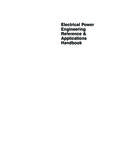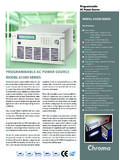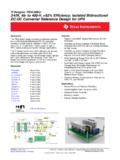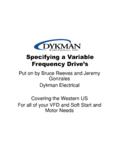Transcription of POWER SYSTEM HARMONICS A Reference Guide …
1 POWER SYSTEM HARMONICS A Reference Guide to Causes, Effects and Corrective Measures AN ALLEN-BRADLEY SERIES OF ISSUES AND ANSWERS By: Robert G. Ellis, P. Eng., Rockwell Automation Medium Voltage Business CONTENTS INTRODUCTION .. 1 HARMONIC FUNDAMENTALS .. 1 CAUSES OF HARMONICS .. 2 POTENTIAL EFFECTS OF HARMONICS .. 3 RECOMMENDATIONS OF IEEE STD 519-1992 .. 4 HARMONIC MODELING AND MITIGATION TECHNIQUES.
2 6 POWER FACTOR IN THE PRESENCE OF HARMONICS .. 7 CONCLUSIONS .. 7 POWER SYSTEM HARMONICS 1 ABSTRACT This paper is intended to give an overview of POWER SYSTEM HARMONICS and is aimed at those who have some electrical background but little or no knowledge of HARMONICS . The basics of HARMONICS including Fourier theory are explained briefly. Common types of harmonic sources present in industry are addressed with particular emphasis on variable frequency drives. The potential ill-effects due to HARMONICS are detailed. The recommendations of IEEE Std. 519-1992 are dealt with. A proactive approach for the addition of large non-linear loads is then presented and alternative methods for harmonic reduction are discussed. INTRODUCTION POWER SYSTEM HARMONICS is an area that is receiving a great deal of attention recently.
3 This is primarily due to the fact that non-linear (or harmonic producing) loads are comprising an ever-increasing portion of the total load for a typical industrial plant. The increase in proportion of non-linear load has prompted more stringent recommendations in IEEE Std. 519 and stricter limits imposed by utilities. Incidence of harmonic related problems is low, but awareness of harmonic issues can help to increase plant POWER SYSTEM reliability. On the rare occasions that HARMONICS are a problem, it is either due to the magnitude of the HARMONICS produced or a POWER SYSTEM resonance. HARMONICS are a mathematical way of describing distortion to a voltage or current waveform. The term harmonic refers to a component of a waveform that occurs at an integer multiple of the fundamental frequency. Fourier theory tells us that any repetitive waveform can be defined in terms of summing sinusoidal waveforms which are integer multiples (or HARMONICS ) of the fundamental frequency.
4 For the purpose of a steady state waveform with equal positive and negative half-cycles, the Fourier series can be expressed as follows: )/sin()(1 TtnAtfnn = = where f(t) is the time domain function n is the harmonic number (only odd values of n are required) An is the amplitude of the nth harmonic component T is the length of one cycle in seconds Understanding the mathematics is not important. What is important is understanding that HARMONICS are a steady state phenomenon and repeat with every 60 Hz cycle. HARMONICS should not be confused with spikes, dips, impulses, oscillations or other forms of transients. SYSTEM HARMONICS HARMONICS "FUNDAMENTALS" POWER SYSTEM HARMONICS 2 A common term that is used in relation to HARMONICS is THD or Total Harmonic Distortion.
5 THD can be used to describe voltage or current distortion and is calculated as follows: )..((%)22221nIDIDIDTHD++= where IDn is the magnitude of the nth harmonic as a percentage of the fundamental (individual distortion). Another closely related term is Distortion Factor (DF) which is essentially the same as THD. HARMONICS are caused by non-linear loads, that is loads that draw a non-sinusoidal current from a sinusoidal voltage source. Some examples of harmonic producing loads are electric arc furnaces, static VAR compensators, inverters, DC converters, switch-mode POWER supplies, and AC or DC motor drives. In the case of a motor drive, the AC current at the input to the rectifier looks more like a square wave than a sinewave (see Figure 1). Figure 1 Typical 6-Pulse Rectifier Input Current Waveform The rectifier can be thought of as a harmonic current source and produces roughly the same amount of harmonic current over a wide range of POWER SYSTEM impedances.
6 The characteristic current HARMONICS that are produced by a rectifier are determined by the pulse number. The following equation allows determination of the characteristic HARMONICS for a given pulse number: h = kq 1 where h is the harmonic number (integer multiple of the fundamental) k is any positive integer q is the pulse number of the converter CAUSES OF HARMONICS POWER SYSTEM HARMONICS 3 This means that a 6-pulse (or 3-phase) rectifier will exhibit HARMONICS at the 5th, 7th, 11th, 13th, 17th, 19th, 23rd, 25th, etc. multiples of the fundamental. As a rough rule of thumb, the magnitudes of the harmonic currents will be the fundamental current divided by the harmonic number ( the magnitude of the 5th harmonic would be about 1/5th of the fundamental current).
7 A 12-pulse (or 6-phase rectifier) will, in theory, produce harmonic currents at the 11th, 13th, 23rd, 25th, etc. multiples. In reality, a small amount of the 5th, 7th, 17th and 19th HARMONICS will be present with a 12-pulse SYSTEM (typically the magnitudes will be on the order of about 10 percent of those for a 6-pulse drive). Variable frequency drives also produce harmonic currents at the output of the inverter which are seen by the motor. Most of these HARMONICS are integer multiples of the inverter operating frequency and not the POWER supply frequency, but little generalization can be made about their magnitude since this varies greatly with the type of drive and the switching algorithm for the inverter semiconductors. Some "interharmonic" currents may also be present at the input or the output of the drive.
8 Interharmonics do not fit the classical definition of HARMONICS since they do not necessarily occur at integer multiples of the POWER supply or inverter fundamental frequency. HARMONICS can occur on the input at the POWER SYSTEM frequency plus or minus the inverter operating frequency. The inverter output can contain HARMONICS at the rectifier pulse number times the POWER SYSTEM frequency plus or minus the inverter operating frequency. Proper DC link design can minimize the presence of interharmonics. POWER SYSTEM problems related to HARMONICS are rare but it is possible for a number of undesirable effects to occur. High levels of harmonic distortion can cause such effects as increased transformer, capacitor, motor or generator heating, misoperation of electronic equipment (which relies on voltage zero crossing detection or is sensitive to wave shape), incorrect readings on meters, misoperation of protective relays, interference with telephone circuits, etc.
9 The likelihood of such ill effects occurring is greatly increased if a resonant condition occurs. Resonance occurs when a harmonic frequency produced by a non-linear load closely coincides with a POWER SYSTEM natural frequency. There are 2 forms of resonance which can occur: parallel resonance and series resonance. HARMON ICS Parallel resonance (see Figure 2) occurs when the natural frequency of the parallel combination of capacitor banks and the SYSTEM inductance falls at or near a harmonic frequency. This can cause substantial amplification of the harmonic current that flows between the capacitors and the SYSTEM inductance and lead to capacitor fuse blowing or failure or transformer overheating. POTENTIAL EFFECTS OF HARMONICS POWER SYSTEM HARMONICS 4 Figure 2 Parallel Resonance X = XihcsihXXcs Series resonance (see Figure 3) is a result of a series combination of inductance and capacitance and presents a low impedance path for harmonic currents at the natural frequency.
10 The effect of a series resonance can be a high voltage distortion level between the inductance and capacitance. Figure 3 Series Resonance Xtih IEEE Std. 519-1992, which is titled "IEEE Recommended Practices and Requirements for Harmonic Control in Electric POWER Systems", is the main document for HARMONICS in North America. This standard serves as an excellent tutorial on HARMONICS . The most important part of this document to the industrial user is Chapter 10 "Recommended Practices for Individual Consumers".

















